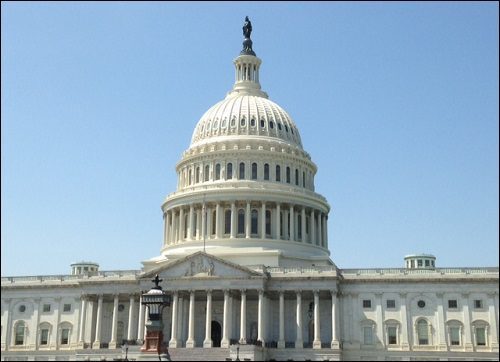Congress approved a government-wide spending measure for the 2018 fiscal year that began Oct. 1 and included billions of dollars in additional funds for federal-aid highway, transit, rail and transportation grant programs.
After negotiating the deal and releasing the documents March 21, the House and Senate were pushing to pass it ahead of the midnight March 23 expiration of the previous stopgap appropriations bill that had held most federal programs to 2017 funding levels.
The House voted 256-167 on March 22 to approve it, and the Senate followed early the next morning in a vote of 65 to 32. President Trump in a tweet threatened to veto the bill over immigration issues, which would have triggered a government shutdown at midnight, but later announced he had signed the measure into law.
With enactment of the spending bill, highway and transit programs would be able to tap the higher full-year 2018 funding levels provided under the 2015 Fixing America’s Surface Transportation Act, as well as billions more that lawmakers provided in infrastructure funding.
In all, a bill summary said, lawmakers approved $7.8 billion in new spending on Department of Transportation-administered infrastructure programs compared with levels enacted for 2017.
That includes $2.525 billion in new spending out of general funds on highways and bridges beyond levels Congress authorized in the FAST Act. It provides a $1 billion increase – to $1.5 billion – for the USDOT’s TIGER project grants, $800 million more in transit formula funding and a $232 million increase to $2.6 billion for transit construction grants that President Trump proposed to end.
It has $1.95 billion for the Amtrak national passenger rail system, a $446.6 million increase, and $888 million for rail infrastructure and safety grants that include new funds for rail lines trying to deploy automated collision-avoidance systems and for federal payment of rail improvement loan costs that formerly railroads would have had to pay.
Lawmakers extended aviation programs another six months through Sept. 30. They provided $1.6 billion more funding than last year, which includes an additional $1 billion for airport improvement program grants and an increase to the contract towers program that ensures all existing towers in that program will be fully funded. And they continued funding at $155 million, up from $150 million last year, for the FAA’s “essential air” program that subsidizes commercial air service to small and rural communities.
The bill also includes $100 million through the Federal Motor Carrier Safety Administration for a highly automated vehicle research and development program.
Outside the USDOT, the omnibus spending bill provides $789 million more to the Army Corps of Engineers for navigation and flood-control projects, plus increases in Commerce Department and EPA programs that provide infrastructure and diesel equipment grants.
Of the additional $2.525 billion for roads and bridges, lawmakers provided that $1.98 billion would be disbursed through formula programs to state DOTs, with the money available for obligation through fiscal 2021.
The American Association of State Highway and Transportation Officials had urged appropriators to channel any additional funding through formula programs directly to state DOTs and transit agencies rather than through discretionary grants that let federal officials decide which projects to support and that require more time for the USDOT to take applications and award funds.
The bill also provides $300 million in new funding for federal lands and tribal projects, $225 million to a new rural highway bridge discretionary grant program in which states also save costs by bundling multiple projects together, plus $15.8 million for Puerto Rico highways and $4.2 million for territorial highways.
The measure also allows states to repurpose unused past funding for congressional earmarks to new projects in those states, and does not rescind any unused highway project contract authority as lawmakers have done at times to offset spending.
Lawmakers increased Federal Transit Administration funding by $1.066 billion from 2017, and included higher amounts than required by the FAST Act for several programs.
The new bill provides $400 million for FTA state-of-good-repair formula grants, $400 million for bus and bus facilities grants, and $30 million for high density state apportionments.
For Amtrak, the summary said “the bill rejects the administration’s proposal to eliminate long-distance routes and funds Amtrak at $1.942 billion . . . This includes $650 million for the Northeast Corridor and $1.292 billion for the national network, which will help to sustain a rail system that serves over 31 million passengers in over 500 communities throughout 46 states.”
The measure includes $543 million in consolidated rail grants, up from $68 million last year. Among them is $250 million for state of good repair grants – a $225 million increase – plus $250 million for positive train control grants ahead of a yearend implementation deadline, a $15 million increase to $20 million for short line rail restoration and enhancement grants, and $25 million in new funds to help small rail lines cover risk premium costs to use low-interest federal infrastructure loans.
The USDOT’s Maritime Administration receives $979 million in the bill, a $457 million hike that includes $45 million more to speed up capital improvements at the U.S. Merchant Marine Academy, $300 million to replace one of six state maritime academy training school ships, and $107 million for the final decommissioning of the N/S Savannah.
Lawmakers also doubled, to $20 million, its small shipyard grant program, and the summary said that “every dollar we invest in improving the capacity and competitiveness of our nation’s shipyards yields six times that in direct and indirect economic activity.”


